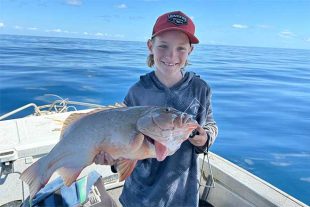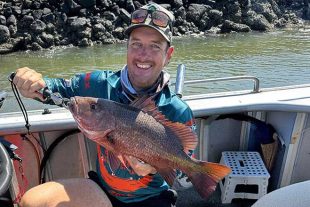To estimate the age of fish, scientists interpret the growth structures of otoliths and count annual growth bands. Knowing the age of fish helps to assess the status of fish stocks.
Using otoliths to estimate age of fish
Otoliths (ear bones) help fish orientate themselves and maintain balance, acting like our middle ear. Otoliths are composed of a form of calcium carbonate and protein which is laid down at different rates throughout a fish’s life. This process leaves bands (alternating opaque and translucent bands) on the otolith like the growth rings in a tree.
The otoliths are located within the skull behind the eye and directly below the brain. Otoliths come in different sizes and shapes depending on the species of fish (see figures 1A and 1B). Otoliths can be slender and fragile (e.g. mackerel and cobia), large and chunky (e.g. barramundi and snapper) or symmetrical in shape (e.g. sand whiting).
Otoliths can either be interpreted whole or they may need to be sectioned, in which case a thin slice is cut from the otolith through the core (see sectioning axis in Figure 2A). Sectioning otoliths enables a clearer view of the banding patterns in some species.
How old is the fish?
Otoliths are interpreted (i.e. they are read) by counting the number of opaque bands between the core and the otolith edge and classifying the otolith margin (the distance between the last opaque band and the otolith edge) (Figure 2B). The width of the otolith margin tells us how long since the fish deposited the last opaque band.
This information is considered along with the date the fish was caught, the “birth date” for the species, and the period during the year when opaque bands are deposited on the otolith, to estimate an age for the fish.
Note: The “birth date” assigned for a species is usually the middle of the spawning period.
Example: The otolith section from a snapper in Figure 3A shows six opaque bands with the last band appearing on the otoliths edge, and it is estimated that this fish was six years old. The Spanish mackerel otolith seen in Figure 3B shows two opaque bands and was estimated at two years old.
© Queensland Government
© Queensland Government
How are age data used?
Being able to work out how old fish are is fundamental to knowing how fast they grow, how old they are when they reproduce and how long they live.
Knowing the relative abundance of fish in different age groups within the population and how this abundance changes over time is very important for assessing the status of that population and the sustainability of the fishery for that species.
Extracted from daf.qld.gov.au
 Bush ‘n Beach Fishing Magazine Location reports & tips for fishing, boating, camping, kayaking, 4WDing in Queensland and Northern NSW
Bush ‘n Beach Fishing Magazine Location reports & tips for fishing, boating, camping, kayaking, 4WDing in Queensland and Northern NSW











